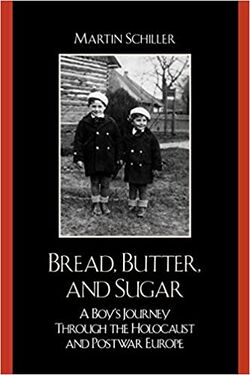Martin Schiller (M / Poland, 1933), Holocaust survivor
Menek Schiller / Martin Schiller (M / Poland, 1933), Holocaust survivor
H. Paul Schiller (M / Poland, 1932), Holocaust survivor
- KEYWORDS : <Poland> <Buchenwald> <Liberation of Buchenwald> <OSE orphanage>
- MEMOIRS : Bread, Butter, and Sugar (2007)
Schiller, Martin. Bread, Butter, and Sugar: A Boy’s Journey Through the Holocaust and Postwar Europe. Lanham, MD: Hamilton Books, 2007.
Biography
Martin Schiller, born on March 10, 1934 in Tarnobrzeg, Poland, discusses the German invasion; Koprzywnica from 1940 to 1941; Skar?ysko from 1941 to 1944; Buchenwald from 1944 to 1945 (Block 30); his involvement in sabotage in the camp; living in Bad Gastein displaced persons camp postwar; and immigrating to the United States in June 1946.
H. Paul Schiller, born on December 4, 1932 in Poland, Tarnobrzeg, discusses the German invasion; Koprzywnica from 1940 to 1941; Skar?ysko from 1941 to 1944; Buchenwald from 1944 to 1945 (Block 23); his involvement in sabotage in the camp; living in Bad Gastein displaced persons camp postwar; and immigrating to the United States in June 1946.
Additional data
Martin Schiller, born in 1933, was a small child living in Tarnobrzeg (Dzikev in Yiddish), a small town in southeastern Poland. According to the 1931 census, of Tarnobrzeg’s 3,643 inhabitants 61 percent were Jewish. Until the German invasion of Poland in 1939, Martin had a happy childhood. Along with his older brother, he grew up in a close-knit, religious family. By the standards of the time, they were well off.
When the war began, the Schillers’ world rapidly collapsed. Martin was barely six. In October 1939, the Germans expelled the Jews from Tarnobrzeg and the Schiller family settled in the nearby shtetl of Koprzywnica (Pukshivnitse in Yiddish). For a time, they hid on the property of an acquaintance whom they quickly came to distrust. In the fall of 1942, when the family’s money had run low and mass deportations to the death camps were in full swing, Martin’s parents made a critical decision: to enter a German labor camp, in this case the HASAG ammunition factories at Skarzysko-Kamienna.
Terrible as it was, Skarzysko was better than many other camps. Since it produced 30 percent of all the German infantry ammunition for the Eastern Front, it was a vital cog in the German war machine. HASAG’s director, Paul Budin, was a ruthless Nazi who cared nothing for Jewish life. But he was a skilled political operator whose wheeling and dealing kept the ultimate authority over the complex in the hands of HASAG, not the SS.
Jewish labor was cheap and Budin was ready to look the other way and admit even children like Martin and his brother. Martin also had another bit of luck. He was sent not to Werk C, which was a mini–death camp, but to Werk A, where the conditions were a little better. And though still a child, Martin grew up fast. He developed a keen instinct for survival. Martin got another prisoner to teach him how to run a vital machine and became valuable to the HASAG operation. Conscious of his status as a skilled worker, Martin felt emboldened to risk his life and ask his German supervisor to save his mother and brother from imminent execution. When Skarzysko was evacuated in the summer of 1944, Martin and his brother were sent to Buchenwald while his mother ended up in a camp near Leipzig.
Liberation was a bittersweet experience for Martin, as it was for many survivors. Martin recalls how the camp experience had made him tough, selfish, and callous. He tried and failed to understand why this had happened, why there had been so much gratuitous brutality and so little kindness. Martin and his brother managed to find their mother, but their world had been totally destroyed. Now they had to decide where to go. A return to Poland brought a shocking reminder that Jews were not wanted there and indeed risked their lives by staying.
Although Martin prepared to go to Palestine, the family’s plans changed when in 1946 his uncles in America sponsored their immigration to New York. The well-meaning uncles enrolled Martin in a yeshiva.
He served in the US Navy as a radio engineer, and later graduated from the University of New Haven with a degree in electrical engineering.He worke as an engineer until his retirement in Florida.
After many years of silence about the war, Martin began to speak about his experiences, and ultimately became a highly-acclaimed speaker.
Book : Bread, Butter, and Sugar (2007)
- Schiller, Martin. Bread, Butter, and Sugar: A Boy’s Journey Through the Holocaust and Postwar Europe (Lanham, MD: Hamilton Books, 2007).
"Based on the true story of Martin Schiller, a child survivor of the Holocaust, this gripping memoir describes the unfolding horror of the Nazi genocide seen through the eyes of a child. "Menek" (Schiller's childhood nickname) was six-years-old when the Nazis invaded Poland, and his family fled eastward from their native Tarnobrzeg. He was nine when he and his family were interned as slave laborers at the Skarzysko concentration camp, where his father perished. As the Russian army advanced, Menek and his brother were deported to Buchenwald, where Menek survived with the help of a sympathetic Block Elder (a German political prisoner) who placed him in a barrack for Russian POWs ... The story of his journey continues after liberation, with their harrowing escape from postwar Poland; the brothers' travels through war-ravaged Germany to find their mother; and the anxiety of the DP camps where the family must decide between Israel or America. This memoir covers the now-emblematic features of a survivor's journey both during and after the war with the intimacy of a young boy's point-of-view, recalling his own thoughts and reactions to events as he tries to make sense of an irrational world."--Publisher description.
